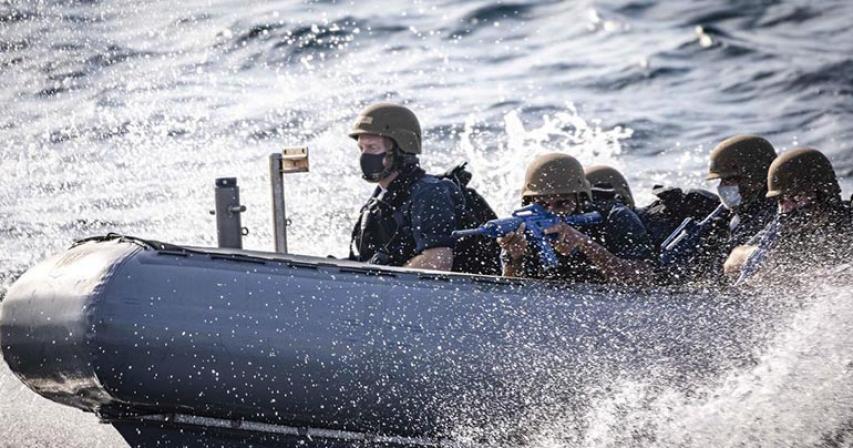Any suggestion that the departure of former US President Donald Trump from Washington would provide a temporary pause in US-China tensions has been swiftly dispelled.
In the short time since President Joe Biden was sworn into office, China has flown more than two dozen combat aircraft near to the self-ruled island of Taiwan and passed a law allowing its coast guard to fire on foreign vessels. Meanwhile, the US Navy has sent an aircraft carrier strike group into the South China Sea.
Analysts say such moves are likely only the beginning of what is expected to be a potentially uneasy initial relationship between the new Biden administration and Beijing.
"China often uses a series of 'tests' to determine a competitor's intentions or willingness to respond to China's actions," said Carl Schuster, a former director of operations at the US Pacific Command's Joint Intelligence Center.
Next steps from Beijing could include large-scale military exercises near Taiwan or in the South China Sea, or stopping foreign vessels in the name of enforcing Chinese maritime regulations, Schuster said.
Beijing will be trying to determine where the Biden administration's "red lines" are, added Schuster.
But incoming Biden Cabinet secretaries have made clear where his administration will stand on Chinese territorial claims in the Indo-Pacific.
"I think China is our most challenging, our most significant challenge going forward," new Defense Secretary Lloyd Austin told his confirmation hearing last week.
The Defense Department would focus on convincing China, or any adversary, that taking on the US military would be "a very bad idea," Austin said.
Here's a look at the three key flashpoints between the two sides:
The South China Sea
China claims almost all of the 1.3 million square mile South China Sea. Since 2014 it has built up tiny reefs and sandbars into man-made artificial islands, fortified with missiles, runways and weapons systems -- antagonizing governments with overlapping claims, including the Philippines, Vietnam, Malaysia, Indonesia, Brunei and Taiwan.
Washington doesn't recognize those claims and regularly sends US warships and military aircraft through the region.
Part of the US presence includes freedom of navigation operations (FONOPS), in which US Navy ships steam within 12 nautical miles -- the limit of a nation's territorial waters under international law -- of land features claimed by China, including the Spratly and Paracel islands.
The US Navy performed 10 such FONOPS in 2020 under the Trump administration, equaling the record number of FONOPS in 2019, according to the US Navy's 7th Fleet.
But the US commitment to freedom of the seas in the South China Sea goes beyond steaming close to islands, as was shown this week by the deployment of an aircraft carrier strike group to the region.
It follows other such high-profile developments in 2020, including the rare decision to deploy two carrier strike groups for exercises in the waterway at the same time.
The US also regularly holds drills with allies and partners in the South China Sea.
China maintains that the presence of American warships elevates tensions in the region and regards US naval patrols as tantamount to interference in the country's domestic affairs.
Meanwhile, Beijing continues to reinforce its own territorial claims, dispatching combat aircraft to airstrips it has built on remote islands, as well as upping the frequency of its naval drills.
That both sides have increased their activity activity in the waterway has alarmed analysts, who point out that the greater volume of traffic, the greater the possibility of inadvertent confrontation.
The US' increased presence in the region is unlikely to change, however. During his run for the presidency last year, Biden recalled how as vice president he told Chinese leader Xi Jinping how the US military would deal with Beijing's self-declared air defense identification zones in the region. "I said we're going to fly through them ... We're not going to pay attention."
Reasons for optimism
Analysts note that even while they engage with the US, countries in the region aren't shutting out Beijing. China is still the world's No. 2 military power and it is always there, right at their doorsteps.
"One of the major challenges facing US policy in recent years has been how to demonstrate that its presence in the region is more than transient, and that its forces can support allies at the speed of relevance," said Sidharth Kaushal, research fellow for sea power at the Royal United Services Institute in London.
"The broad message of Chinese policy to regional actors has been that the US Navy may come and go but China is a permanent feature of their security environment," he said.
Kaushai said Chinese activities such as harassing fishermen in the South China Sea or challenging energy and mineral rights tend to diminish when US forces are active, then ramp up when they leave, "essentially sending the message to local powers that the Americans won't be available forever but the Chinese will."
That leaves all the actors involved with a dilemma, said Schuster.
"The challenge is in finding the balance between demonstrating deterrence and commitment, and unnecessary escalation," he said.
"Regional leaders are happy with the US presence as it serves to check Chinese behavior. But they want nothing to do with choosing between the two superpowers," Schuster said.
China, too, has reasons to dial back tensions in 2021.
The Chinese Communist Party marks its 100th anniversary this year, and it will be expected to deliver on domestic policy goals -- so foreign policy confrontations could divert attention and resources, said Timothy Heath, senior defense researcher at the RAND Corp think tank in Virginia.
"This provides a strong incentive for China to avoid provocative actions or instigating conflict along its periphery."

Comments